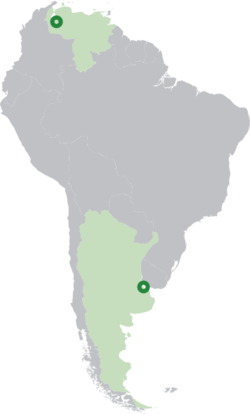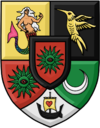Haronos Plan

The Haronos Plan (Sabian: haronoñkoxagi; Middle Sabian: tistta Haronos, [xaˈɾɔnos]; lit. "Charon plan"), often known simply as Haronos was a Sabioveronese initiative to promulgate mass migration from the Valtir to Argentina and claim territory in Buenos Aires in 2015. The plan was devised to lower the effects of the ongoing political and economic unrest in Venezuela following the 2014–15 protests, in Sabia and Verona's internal affairs. The plan was divided into two stages: Haronos I, executed between 24 and 25 August 2015, and Haronos II, executed between 29 and 30 September 2015.
Tha plan was developed by a group of Sabioveronese védalar politicians from different political parties, including Napoléon Bleuberrie, Léon Galieri, Anton Schubert-Moss and Ulla Müller, among others. The Congress of Salisse, summoned by Prime Minister Bertrand Rivière and held on 16 August 2015, outlined most of the plan.
Over 20% of Sabia and Verona's provincial population emigrated just in Haronos I. Consequences of the plan included the abdication of Queen Isadora and the coronation of Tarik of Kârjasary as King of the Valtirians, the adoption of a new constitution that dramatically shifted the balance of power and dissolved nearly all existing institutions, and the move of the capital from Salisse to the newly founded city of Alios.
Background

It's widely accepted the source of the problems leading to the implementation of Haronos was the economic and social situation in Venezuela, nation that borders Sabia and Verona's Northern Territories, which were, at the time of the creation of the plan, all of Sabia and Verona's claims.[1] The aftermath of the 2014 Venezuelan protests and the months leading to the 2015 Venezuelan National Assembly elections were especially critical. In March 2015, members of the prominent Sabioveronese House of Kârjasary, to which former Governor Tarik Kârjasary, Duke of Evra belonged, decided to leave Sabia and Verona for Argentina.[1]
Sabia and Verona had been internally inactive since early 2015, as a result of the failure of Bertrand Rivière's policies and a general lack of interest from the védalar of Sabia and Verona. The upper house of the Courts had met once since the 2014 general election and the lower house had met only a couple of times, only to approve a grand total of two laws aside the Aishaierovê. On 12 July 2015, the Prime Minister officially dissolved the Courts and assumed full executive powers as High Commissioner of Sabia and Verona.
When the news of the House of Kârjasary's planned departure broke, several Sabioveronese védalar asked for a chance to leave alongside them. It was then that the idea of an organized mass migration to Argentina came up, suggested by various politicians of the parties in opposition to Rivière's Unity Party, such as the Left Alliance. It was Narcissus Clyne who proposed the name of "Haronos Plan", and after several public meetings between Left Alliance and Convergence, the plan's basic structure was decided.
The idea was to form a community outside the Valtir. As explained by Clyne, Haronos would consist of two stages: Haronos I, which was executed between August 24 and August 25, and Haronos II, which would be executed between September and October. Participants of Haronos I, directed by the Duke of Evra, would get to Buenos Aires directly by plane, and would decide whether to carry on with either of two proposed outcomes: Kapakoxouny ("Horizons") and Jarâman ("Freedom"). Kapakoxouny proposed establishing a new settlement which would serve as Sabia and Verona's new capital, from which the entire nation would be administered; Jarâman proposed establishing a completely new state, independent from Sabia and Verona but still a province of the FUJL. Participants of Haronos II would get to Buenos Aires by land, crossing South America through the Transandean Highway. The division of the plan into two stages was due to the limited capacity of provincial citizens that could be carried in each travel. Over 20% of the Sabioveronese provincial population became part of Haronos I, as much as could be transported from the Valtir to Argentina in the direct flight.[1]
Congress of Salisse

Fearing for the state in which the Kingdom would be left once the plan was executed, Rivière summoned the Sabioveronese people to a "Congress in Salisse". The congress was a public meeting of important political leaders of the region, including the Left Alliance's Bleuberrie, Léon Galieri, Ulla Müller and Snø Jens, Unity's Osez Kóvérsz, Dimeros Grenouille and Mei Xiongmao, Convergence and Amity's Étienne Boulin, Apollo and Hidram Cerwyn, and Rivière himself. The congress was held on August 16 in Salisse, which gave it its name. Many of these political figures were involved in Haronos I, and some in Haronos II. Two main objectives were set for the congress: deciding what the fate of the Sabioveronese state would be and writing a new constitution if needed. It was decided a new constitution would be written and it would be adopted in case Kapakoxouny was carried out. In the event of Jarâman being executed instead, some minor reforms to the 2014 constitution would be enacted instead. The new constitution, written from August 15 to August 20, was initially known as the "Konstitutsios reporas", the "Just-in-case Constitution".

However the overwhelming reality was that Kapakoxouny would be executed, as the cultural, social and economic consequences of executing Jarâman were too radical compared to those of Kapakoxouny, and there was a general reluctance from the Sabioveronese people to create a new state, as this could be potentially seen in a negative light, due to the sector's past instability. By the time the Congress at Salisse had ended it was already widely accepted Kapakoxouny would be chosen over Jarâman, and the next day on August 17, during a visit to Salisse Queen Isadora signed an Instrument of Abdication (Érianos Metavrosann) which was to come into effect on 23 August 2015, on the 18 month anniversary of her reign. The Instrument was signed in face of the complications of having the ruling monarch live 4800 miles away from the country's administrative centre, one of the reasons Isadora was crowned in the first place: to replace King Ciprian who had ruled from Juclandia. Rivière, as the leader of all of Sabia and Verona at the time in his capacity as Prime Minister (the office of Governor of Sabia and Verona and the Legislative Courts dissolved since late July), had the option of upholding Isadora's abdication or disregarding it if Jarâman was indeed carried out.
Rivière upheld Isadora's Instrument of Abdication, and on 23 August, the Duke of Evra was crowned the new King of the Valtirians by lack of any other suitable electors.[2]
Execution
Haronos I — August
The first convoy, consisting of twenty Sabians, Veronans and Lyceni, left Sabia on the night of Sunday, August 23, and arrived in Caracas on Monday. On Wednesday, the convoy left for Buenos Aires at 15:15 Caracas time (following a 15-minute delay at Maiquetía International Airport) and arrived at 23:20 Buenos Aires time. As it had been foreseen, Kapakoxouky was carried out. That night, the participants, headed by the new King, founded city of Alios and proclaimed it to be the new capital of the Kingdom of Sabia and Verona, and the "Just-in-case" constitution became the new official constitution of Sabia and Verona. The Courts and the government were officially disbanded, and a caretake government headed by Léon Galieri took over on August 26.
Haronos II — September
The second convoy counted with a significantly lower amount of participants, which were mostly Elinoreans of Caenia and Elinor-Lox. Among the participants were the remaining members of the Sabian nucleus of the royal family —the Countess of Nicoya, the Marquis of Saint-Martin and Ivan Noajasê— with the exception of Runa Bartolucci, who stayed in the North to watch over the Kârjasary's holdings. The convoy left Sabia on Sunday, September 27 and arrived in Caracas the same day. On Thursday, the participants left for Buenos Aires, arriving at midnight.
References
- ↑ 1.0 1.1 1.2 "The eternal laurels, the peculiar Exodus and the Braganza way". The SiV Phonograph. 14 August 2015.
- ↑ "Triangle Triceratops Trimester Trivia: Three years of Sabia and Verona". The SiV Phonograph. 20 October 2015.
